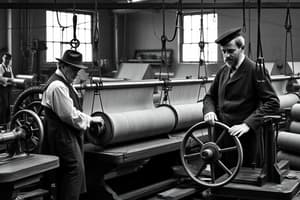Podcast
Questions and Answers
Who invented the Power Loom in 1784?
Who invented the Power Loom in 1784?
- Thomas Highs
- Richard Arkwright
- James Hargreaves
- Edmund Cartwright (correct)
What was a key feature of the Power Loom compared to earlier looms?
What was a key feature of the Power Loom compared to earlier looms?
- It could only weave cotton fabric
- It was slower than manual weaving
- It could weave different types of fabric (correct)
- It required more skilled labor to operate
Which invention allowed for the mechanization of spinning processes during the Industrial Revolution?
Which invention allowed for the mechanization of spinning processes during the Industrial Revolution?
- Spinning Mule (correct)
- Power Loom
- Water Frame
- Flying Shuttle
What impact did the Power Loom have on the textile industry?
What impact did the Power Loom have on the textile industry?
Which inventor is associated with the Water Frame?
Which inventor is associated with the Water Frame?
What writing material was commonly used by the Sumerians for cuneiform writing?
What writing material was commonly used by the Sumerians for cuneiform writing?
Who ruled over the Sumerian city-states and often claimed descent from gods?
Who ruled over the Sumerian city-states and often claimed descent from gods?
What was the purpose of applying a clay mixture known as 'bitumen' on clay tablets?
What was the purpose of applying a clay mixture known as 'bitumen' on clay tablets?
What made cuneiform writing a highly flexible system that could adapt to changing languages and cultures?
What made cuneiform writing a highly flexible system that could adapt to changing languages and cultures?
What was the primary reason for the development of cuneiform writing?
What was the primary reason for the development of cuneiform writing?
What does an ideographic sign represent in cuneiform writing?
What does an ideographic sign represent in cuneiform writing?
Which civilization is deeply associated with the roots of cuneiform script?
Which civilization is deeply associated with the roots of cuneiform script?
What was a significant factor contributing to the evolution of cuneiform into a more streamlined version?
What was a significant factor contributing to the evolution of cuneiform into a more streamlined version?
How did cuneiform writing express meaning through signs and symbols?
How did cuneiform writing express meaning through signs and symbols?
Which script eventually replaced cuneiform following the decline of the Babylonian Empire?
Which script eventually replaced cuneiform following the decline of the Babylonian Empire?
Flashcards are hidden until you start studying
Study Notes
Textile Industry Inventions During the Industrial Revolution
The textile industry underwent significant changes during the period of the Industrial Revolution due to numerous innovations that revolutionized the manufacturing process. Three major inventions were instrumental in shaping this transformation: the Water Frame, Spinning Mule, and Power Loom.
Water Frame
The Water Frame, also known as the Water Frame Spinning Jenny, was a spinning machine developed by James Hargreaves around 1764. This machine was the first of its kind to use water power to drive a spinning wheel. The Water Frame allowed spinners to produce yarn much faster than by hand. It was a crucial invention for the textile industry, contributing to the mechanization of spinning processes and increasing productivity.
Spinning Mule
The Spinning Mule was another invention by James Hargreaves around 1769. Unlike the Water Frame, which was a spinning machine, the Spinning Mule was a spinning frame. It allowed the spinning of cotton, wool, and other fibers. The Spinning Mule was a significant improvement over the Water Frame because it could handle both cotton and wool, which are difficult to spin together. This invention made it possible to produce stronger, more consistent yarn, which was essential for the production of high-quality textiles.
Power Loom
The Power Loom was a spinning and weaving machine that revolutionized the textile industry. It was invented by Edmund Cartwright in 1784 and was the first machine capable of weaving cloth from cotton and wool. The Power Loom allowed for the mechanization of weaving, which was a time-consuming and labor-intensive process. This invention greatly increased the production of woven cloth and reduced the need for skilled labor.
The Power Loom was an improvement over earlier looms because it could weave different types of fabric, including wool, silk, and cotton. It also allowed for the production of more complex patterns and designs. This invention was crucial for the growth of the textile industry and the development of mass-produced textiles.
In conclusion, the Industrial Revolution was a period of significant change in the textile industry, driven by the innovations of inventors like James Hargreaves and Edmund Cartwright. The Water Frame, Spinning Mule, and Power Loom were crucial inventions that allowed for the mechanization of spinning and weaving processes, leading to increased productivity and the growth of the textile industry.
Studying That Suits You
Use AI to generate personalized quizzes and flashcards to suit your learning preferences.




